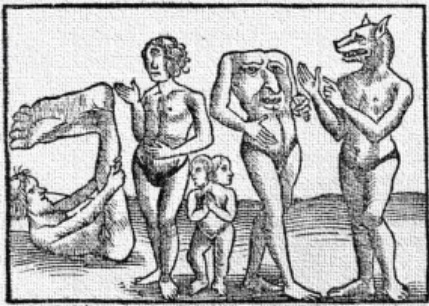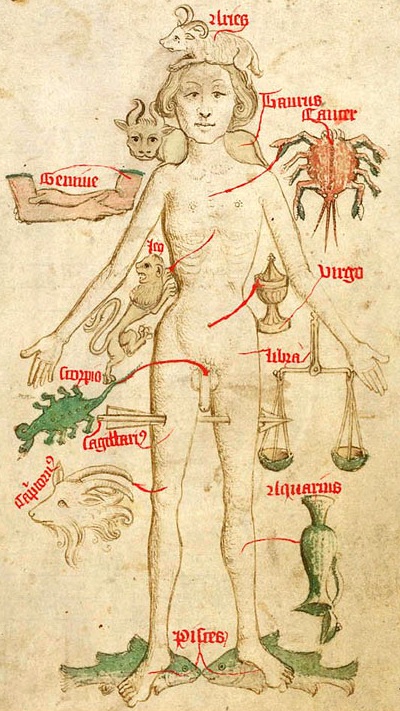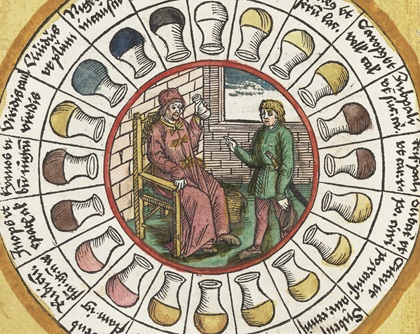|
|
|
PhysiologyPhysiology is 'the study of how the body works' ... and medieval scholars had little idea about how the human body worked. • They accepted from Ancient Greek writers (primarily Hippocrates and Galen) the Theory of the Four Humours – that the body comprised four 'humours' (bodily fluids); these could be hot, dry, cold or wet, and determined, not only health, but personality. • They realised that the heart pumped blood, but thought the muscles burned it up as fuel. They believed that the arteries carried both air and blood, and that breathing was to cool the heart. • They thought that food was turned into 'natural spirits' (nutrition) in the liver, 'vital spirits' (energy) in the heart and 'animal spirits' in the brain (animal spirits travelled through the nerves and created movement by inflating the muscles). • Many medieval physicians believed that the seat of emotions was the bowels (hence 'gut feeling'). • They were flummoxed by the brain. Some medieval physicians followed the Greek philosopher Aristotle, who held that the heart was the centre of thoughts and feeling and that the brain was an organ which cooled the blood (thus 'hot-headed'). Others believed that the vital spirits flowed from the heart into the brain, where they were transformed into thoughts, feeling and movement. Galen taught that the brain was the location of the soul. • They misunderstood even the basics of conception. They did not know about eggs or the role of the sperm in fertilization. Another idea was that the left testicle produced a female baby and the right a male. • The physiology of women was particularly bizarre: ◦ They thought that men were hotter and drier than women. Because colder, women’s bodies were therefore less efficient than men’s, which not only led to women’s illnesses, but explained why they weaker, and more sly and cold-hearted. ◦ They thought that both men and women produced ‘seed’ for conception. Menstruation (‘women's flowers’) was the purging of a build-up of female seed; later medieval writers claimed that, while male seed was precious, female seed was poisonous – it would turn wine sour and dogs rabid, and kill fruit and bees. ◦ When a woman failed to menstruate, it could lead to ‘uterine suffocation’; the womb became dry and wandered round the body seeking moisture, leading to 'hysterical panic' (from the Greek word hystera, 'womb'), convulsion, fainting and madness. ◦ They believed that the womb had a sense of smell, which was why hysteria could be cured by smelling salts made from pitch, burnt hair or castoreum (a secretion made from the scent sacs of beavers). • They believed that astrology, demons and supernatural influences controlled people's lives.
|
Going DeeperThe following links will help you widen your knowledge: Basic account from BBC Bitesize
Case Study: The Black Death
YouTube Mr Cloke on the Theory of the Four Humors, Hippocrates, Galen and the Causes of Disease
Did You KnowMuch of what we know of medieval ideas about the physiology of women comes from three books – known collectively as the Trotula – written in Salerno in Italy in the 12th century. Ascribed to a woman doctor called Trota, it is thought that only one of them was written by a woman. The other two were written by men, for men..
Source A
The Travels of Sir John Mandeville (1356), describing the wonders he encountered on an alleged journey to China, including fantastic human beings. The book remained authoritative until c.1600.
Source B
Homo Signorum ('Man of Signs') a zodiac man from the Guid of Barber-Surgeons, c.1486, showing the parts of the body dominsated by the various astrological divisions.
Source C
A medieval urine chart from Germany, c.1506. One way that doctors would determine a ptient's humours was by checking the colour, thickness, smell and taste of the patient’s urine.
|
PathologyPathology is 'the study of how causes of disease' ... and medieval scholars had little idea about what caused disease. The result was a bewildering and contradictory array of ideas including: 1. The Theory of the Four Humours – as propounded in the works of Hippocrates and Galen. Was the person cold or hot, wet or dry and, given this, which of the four bodily humours (blood, phlegm, yellow bile or black bile) had got out of balance? 2. Astrology – became more important as the Middle Ages progressed, especially after the Black Death. 3. Pestilential (or corrupted or putrefied) air – people were aware of the connection between disease and smell, but blamed the smell for the disease. 4. Contagion – medieval doctors also realised that some diseases were contagious, but were not aware how. 5. Divine punishment – diseases such as leprosy were regarded as a punishment for the patient’s sin, epidemics as a punishment for society’s sins. 6. Supernatural signs and evil spirits. Epilepsy was widely believed to be caused by demonic possession or evil spirits entering the body; ergotism (a very painful disease caused by eating mouldy rye and called 'St Anthony's Fire') was believed to be a test of faith from God. 7. Jews and witches – Jews might be accused of poisoning the wells; old women of casting bad spells.
NOTE: You will see all of these ideas when you study
|
|
DiagnosisMedieval ideas about the causes of disease are a huge overlapping muddle. If you had trained at Oxford University, you had probably read a textbook called Ars Medicinae ('The Art of Medicine', sometimes called the Articella: ‘Little Art’) – a compilation of extracts from the Greek doctors Hippocrates and Galen, together with passages on urine and the pulse. Other common texts included Avicenna’s Canon (‘collection’) and compendiums of medical knowledge by English writers – the Rosa Anglica (‘English Rose’) by John of Gaddesden, and Compendium Medicinae by Gilbert of England (Gilbert’s section on childbirth and gynecology was circulated as a separate book: The Sickness Of Women). Ordinary practitioners carried a Vademecum (‘Go-with-me’) – a quick-reference flip-book of strips of parchment containing the position of sun and moon when the illness began; the planet ruling the afflicted body part; the Sphere of Apuleius (which used the patient's name to predict whether they would live or die); the zodiac man and a roundel of different colours of urine.
Medicine was seen as an ‘art’ – a skill not a science. As you will see when you study the Black Death, a doctor might use ALL the above ideas and his natural intuition to diagnose the cause of the disease, and to decide the best treatment.
|
|
Determining factors:Communication – the Dark Ages had seen the loss of medical learning. After 1000, Arab Christians set about translating the texts of Greek authorities such as Hippocrates and Galen, and these translations (very) slowly began to be used in universities across Europe. There is little evidence that this knowledge ‘trickled down’ to ordinary practitioners. Science and learning – books like the Articella, Canon and Rosa Anglica were typical of medieval learning (compiling and organising existing knowledge). Hippocrates and Galen were simply incorporated (mistakes and all) into a huge often-contradictory body of information and doctors picked and chose as they wanted. Diagnosis was seen as an ‘art’; it was in no way a ‘science’ as we know science … which is why it was all wrong. Attitudes: Faith – Christianity was important in the acceptance of Galen, because he believed in one God, which pleased the Church. Other influences were wholly negative – blaming the patient for their sin, or Jews and witches, or evil spirits.
Attitudes: Authority – the acceptance of authority over even the evidence of your own eyes made it difficult-to-impossible to change anything. The 13th century French surgeon Henri de Mondeville realised that Hippocrates and Galen were 'old dogs that needed putting down', but even he used their methods: “he probably wouldn’t have found employment otherwise” (Stark & Thorne, 2016 – as they point out, there were no alternative ideas available).
|
Consider:1. How useful is Source C to an historian studying medieval physiology and diagnosis? 2. Explain the significance of the following for
medieval physiology and diagnosis:
3. Did medieval physiology and diagnosis
'stand still' in the Middle Ages? 4. What was the main influence determining physiology and diagnosis in the Middle Ages. 5. Study the information on Causes in the Case Study on the Black Death. Make a list of causes suggested at the time and link each to the seven main ideas about the causation of disease listed on this webpage.
|
|
|
|
|
Spotted an error on this page? Broken link? Anything missing? Let me know. |
|


